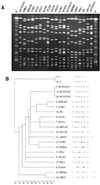Three-year assessment of methicillin-resistant Staphylococcus aureus clones in Latin America from 1996 to 1998
- PMID: 11376057
- PMCID: PMC88111
- DOI: 10.1128/JCM.39.6.2197-2205.2001
Three-year assessment of methicillin-resistant Staphylococcus aureus clones in Latin America from 1996 to 1998
Abstract
Four hundred ninety-nine methicillin-resistant Staphylococcus aureus (MRSA) isolates recovered from 1996 to 1998 from 22 hospitals in five countries of Latin America-Argentina, Brazil, Chile, Uruguay and Mexico-were examined for antimicrobial susceptibility and clonal type in order to define the endemic clones in those hospitals. The hybridization of ClaI restriction digests with the mecA- and Tn554-specific DNA probes combined with pulsed-field gel electrophoresis of chromosomal SmaI digests (ClaI-mecA::ClaI-Tn554::PFGE clonal types) documented not only the predominance and persistence of the Brazilian clone (XI::B::B) in Brazil (97%) and Argentina (86%) but also its massive dissemination to Uruguay (100%). Moreover, a close relative of the Brazilian clone (XI::kappa::B) was highly represented in Chile (53%) together with a novel clone (47%) (II::E'::F) resistant to pencillin, oxacillin, ciprofloxacin, chloramphenicol, clindamycin, erythromycin, and gentamicin. A unique clonal type (I::NH::M) was detected in Mexico among pediatric isolates and was resistant to penicillin, oxacillin, and gentamicin only. This study clearly documented the very large capacity for geographic expansion and the persistence of the Brazilian clone, contributing not only to the increasing uniformity of the MRSA in South America but worldwide as well.
Figures




References
-
- Aires de Sousa M, de Lencastre H, Santos Sanches I, Kikuchi K, Totsuka K, Tomasz A. Similarity of antibiotic resistance patterns and molecular typing properties of methicillin-resistant Staphylococcus aureus widely spread in hospitals in New York City and in a hospital in Tokyo, Japan. Microb Drug Resist. 2000;6:221–226. - PubMed
-
- Chung M, de Lencastre H, Matthews P, Tomasz A Multilab Project Collaborators I. Adamsson, M. Aires de Sousa, T. Camou, C. Cocuzza, A. Corso, I. Couto, A. Dominguez, M. Gniadkowski, R. Goering, A. Gomes, K. Kikuchi, A. Marchese, R. Mato, O. Melter, D. Oliveira, R. Palacio, R. Sá-Leão, I. S Sanches, J. H. Song, P. T. Tassios, and P. Villari. Molecular typing of methicillin-resistant Staphylococcus aureus by pulsed-field gel electrophoresis: comparison of results obtained in a multilaboratory effort using identical protocols and MRSA strains. Microb Drug Resist. 2000;6:189–198. - PubMed
-
- Corso A, Santos Sanches I, Aires de Sousa M, Rossi A, de Lencastre H. Spread of a dominant methicillin-resistant multiresistant Staphylococcus aureus (MRSA) clone in Argentina. Microb Drug Resist. 1998;4:277–288. - PubMed
Publication types
MeSH terms
Substances
LinkOut - more resources
Full Text Sources
Medical

